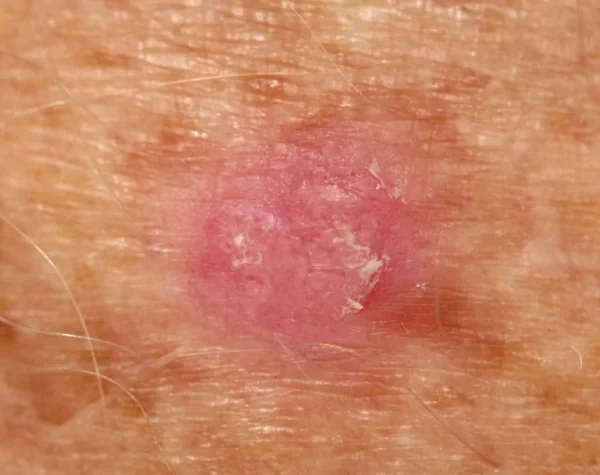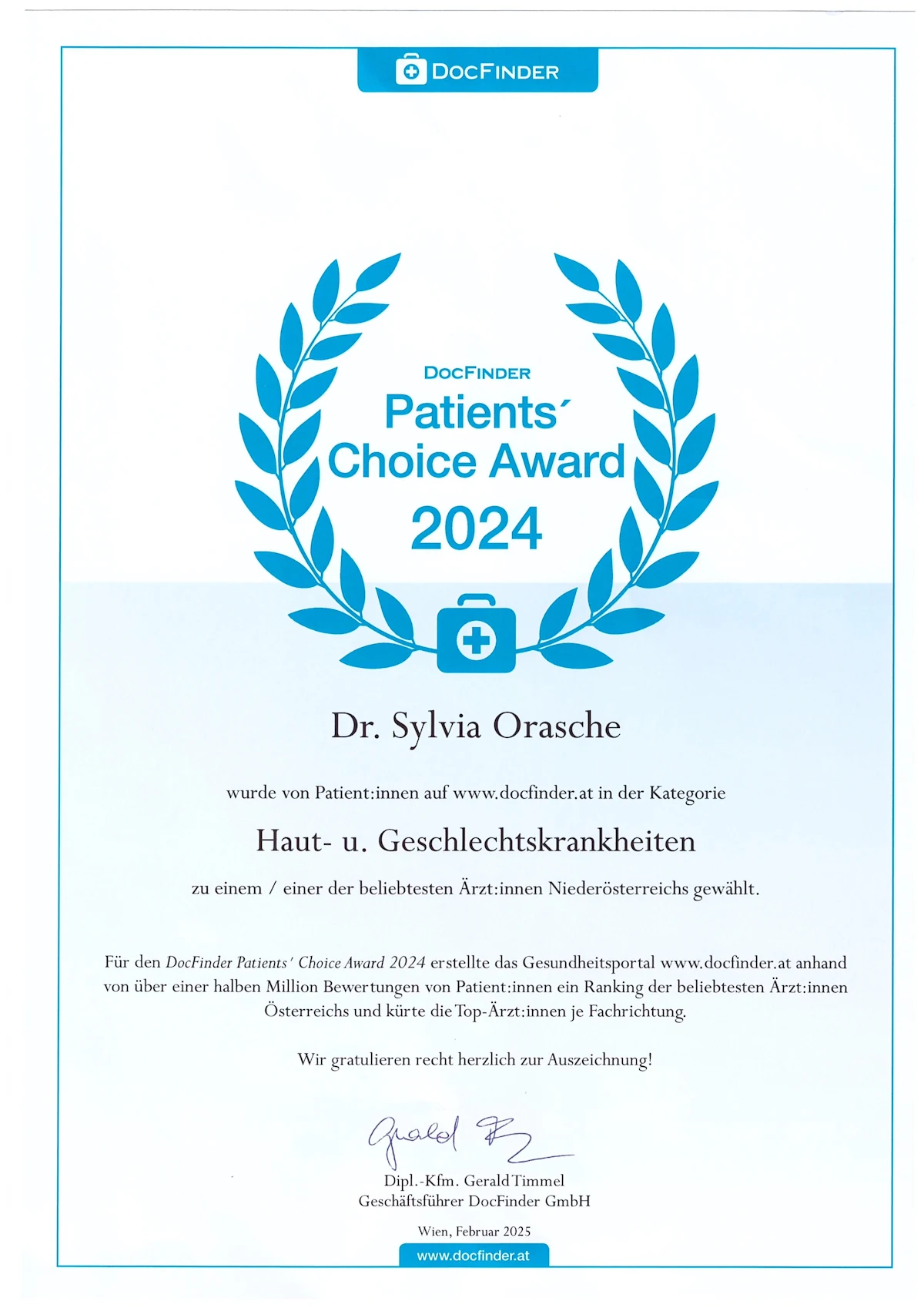Daylight PDT treatment overview
- Daylight PDT uses a combination of a photosensitising agent and daylight to specifically destroy cancer cells.
- The active ingredient is applied to the affected area of skin and accumulates in the cancer cells.
- When exposed to daylight, the active substance is activated and forms reactive oxygen species that destroy the cancer cells.
PreparationThe skin is thoroughly cleansed and possibly slightly exfoliated to improve absorption of the active ingredient.
Application of the active substanceThe photosensitising agent is applied to the affected areas of skin.
Application timeThe active ingredient needs about 30 minutes to 2 hours to penetrate the skin and accumulate in the cancer cells.
ExposureThe skin is then exposed to natural daylight for around 1.5 to 2 hours. It is important to avoid direct sunlight and to carry out the treatment in diffuse daylight.
The treatment lasts approx. 30 minutes. Afterwards, the patient must be exposed to daylight for approx. 2 hours. Ideally, the treatment should be carried out when the outside temperature is mild to warm. This is best after or before winter.
- Mild skin reactionsRedness, swelling and slight pain or burning are common and usually subside within a few days.
- PhotosensitivityDuring and after treatment, the skin is more sensitive to light and it is recommended to avoid intense sunlight for a few days.
- Daylight PDT is particularly effective in the treatment of flat, non-hyperkeratotic actinic keratoses and has a high success rate.
- Several treatments may be required, depending on the severity and number of skin lesions.
- The treated skin area should be checked regularly for relapses or new lesions.
- It is recommended to use sunscreen and protect the skin from overexposure to the sun.
First ordination: from 150,- €*
Treatment: from 340,- €*
*Guide prices: The treatment costs depend on the treatment area, the number of actinic keratoses and the extent to which they have developed.
Photodynamic therapy vs. daylight PDT
Until recently, the treatment of white skin cancer The treatment was carried out using the conventional form of PDT, which utilised strong red light. A light sensitiser is applied to the skin, which is particularly strongly absorbed by tumour cells. The short but intense irradiation with a special light leads to the release of oxygen radicals in the malignant cells, which are then destroyed. Although this method is efficient, it can also be painful.
The gentle Daylight PDT on the other hand, is almost painless and is in no way inferior to conventional PDT in terms of success. With the new method, irradiation takes place immediately after the ALA cream is applied. The solar radiation results in much less pain and it is usually not necessary to take painkillers.
The innovative PDT with daylight has the advantage that it can be repeated several times without damaging healthy body tissue. It is suitable for the treatment of actinic keratoses over large areas (entire face), superficial basal cell carcinomas or Bowen's disease. Daylight PDT is also a modern treatment alternative for preventing skin cancer and rejuvenating the skin.
How does a daylight PDT work?
The skin analysis
In the course of an initial examination, it is determined whether lesions suspected of being cancerous are present. Based on the results of the medical photo documentation, we will discuss whether treatment is necessary. We will introduce you to the latest treatment options and discuss their advantages and disadvantages. If you decide in favour of a daylight PDT, we will arrange a suitable appointment with you.
The treatment
On the day of treatment, a sun cream with a sun protection factor of 50 is first applied. Crusts are then removed and more severe lesions may be treated with other methods such as the fractional CO₂ laser pre-treated. A light-sensitising cream is then applied and the patient must spend about 2 hours outdoors, walking or sitting in the park. Studies have shown that an overcast sky or cooler weather is no obstacle to carrying out a light sensitisation treatment. Daylight PDT represent.
Irradiation with daylight is very gentle and usually completely painless, but should in any case last a total of 2 hours without interruption. Chemical processes are set in motion that destroy skin changes. This is known as the "photodynamic effect". Malignant cell changes can be gently removed in this way.
As the chemical reaction in daylight PDT occurs evenly and slowly, it is less painful than conventional PDT.
Control
A check-up is recommended after approx. 4 to 6 weeks. A decision will then be made as to whether further treatment is necessary.
Frequently asked questions about daylight PDT
Is a daylight PDT painful?
During the treatment you usually only feel a slight sensation of warmth, after the therapy there is a deliberate inflammatory reaction with redness or slight swelling, similar to sunburn.
What should I not do after PDT treatment?
- You should avoid bathing or showering on the day of treatment.
- Avoid perfumes or deodorants with fragrances.
- Sport should be avoided for two or better three days.
- As long as the treated areas are reddened, a high level of sun protection must be ensured or exposure to the sun must be avoided for the following days.
- The experts in the Surgery of Dr Orasche will provide you with sufficient advice in this regard.
When should PDT not be performed?
Contraindications to PDT are
- Pregnancy
- Allergy to the photosensitiser
How does PDT work?
The procedure is relatively uncomplicated and works with the help of a photosensitiser that accumulates locally in the tumour. After the application of a special cream, the tumour is irradiated with light of a specific wavelength or sunlight. This destroys the tumour cells through photophysical processes. After the treatment, the skin looks reddened and feels like it has been sunburnt. After a few days, the healing process is complete. The skin appears revitalised and regenerated without any visible scars remaining.
What are the advantages of photodynamic therapy?
Compared to other surgical methods, PDT is a non-invasive, uncomplicated and skin-friendly form of therapy. The healing success is not inferior to that of surgery, and the treated tumours usually heal faster and without scarring.
An innovative form of PDT is the less painful daylight PDT. If, contrary to expectations, the desired success is not achieved after a period of observation, it is possible to repeat the treatment or to schedule another form of therapy such as cryotherapy or curettage.
What is photodynamic therapy?
Photodynamic therapy (PDT) is an effective and gentle skin cancer therapy. With the help of light, malignant forms of skin cancer or their precursors can be treated effectively. Damage caused by UV radiation often only becomes noticeable years later. Areas of skin that are exposed to sunlight over a long period of time are particularly affected, especially the face and forearms, but the shoulders and décolleté are also affected.
In the early stages, all types of skin tumours can be treated and cured on an outpatient basis. Photodynamic therapy can be used to treat actinic keratoses, which are a precursor to skin cancer, basal cell carcinomas and other superficial forms of skin cancer.
Actinic keratoses appear as reddish or skin-coloured changes to the skin. They are rough to the touch.
The PDT method is suitable for tumours that extend less than 3 mm into the skin.
Are there any side effects with PDT?
Side effects are extremely rare with photodynamic therapy.
As with any treatment, undesirable side effects can also occur with PDT:
- Pain during radiotherapy (daylight PDT is painless)
- Severe reddening of the skin
- Oedema
- Strong discolouration of the treated skin areas
- Allergies to the ointment for photosensitisation
- Formation of scars
The risk of such side effects is lower with daylight PDT.
What are the advantages of a daylight PDT?
- Non-invasiveNo surgical intervention necessary.
- Cosmetically favourableLess scarring compared to surgical methods.
- Patient comfortLess pain and faster recovery times.
- ConvenienceDaylight PDT can often be performed outdoors, which makes the treatment more comfortable.



